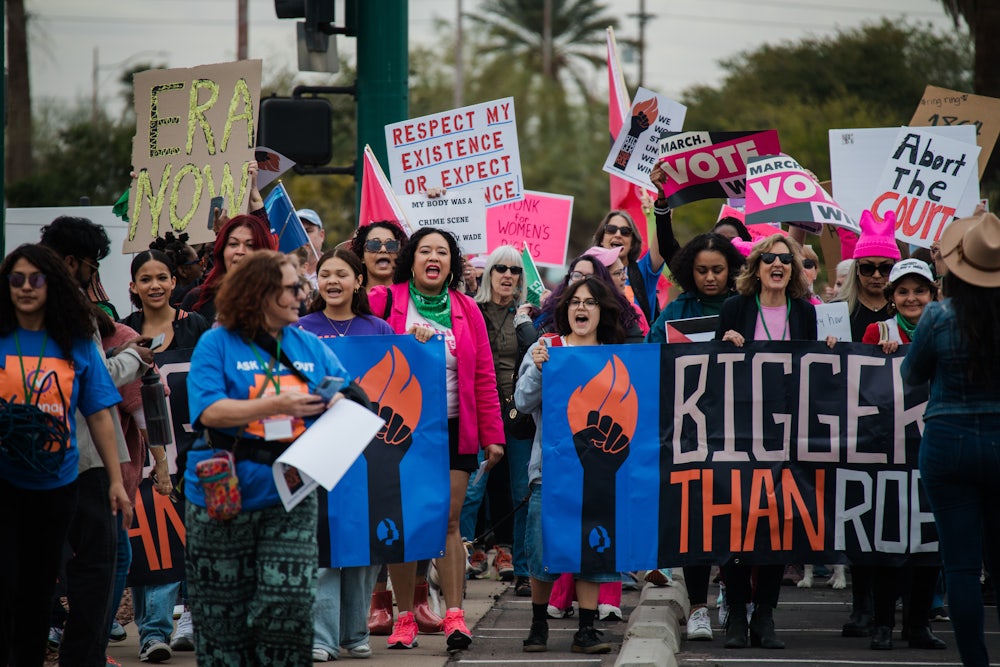If you want to know what threats to democracy might look like going forward, you do not have to imagine Trump returning to the White House and refusing to leave ever again. Instead, you need only look to what’s going on in states right now, from abortion bans to attacks on queer and trans people, as a new report from the nonprofit Movement Advancement Project, or MAP, illustrates. Attacks on democracy and attacks on bodily autonomy are more closely connected than some might imagine.
The new report, Freedom Under Fire: The Far Right’s Battle to Control America, released Wednesday by MAP, considers the connections between different kinds of attacks on freedom. “These varied attacks may seem disparate and disconnected, but in fact they are part of a coordinated campaign,” noted Tessa Juste, a MAP researcher. The report identifies six overarching categories of attack: “restricting health care and the right to make decisions about one’s body”; “restricting freedom of ideas and the ability to obtain a comprehensive education”; “restricting travel and the ability to exist freely in public places”; “restricting the legal recognition of people’s identities”; “restricting freedom of the press, speech, and assembly”; and “restricting the right to vote.” The goal of all of these types of attacks is twofold and mutually supporting: “mainstreaming exclusion and undermining democracy.”
Taking these lines of attack together, the headline-making threats of the past decade can easily be understood as feeding into a comprehensive story of the unraveling of democracy: the Dobbs decision and the near-total abortion bans in its wake, “Don’t Say Gay” and anti–“critical race theory” laws, denying identification documents to immigrants and trans and nonbinary people, new immunity laws for those assaulting protesters and journalists, harassment and threats of violence targeting people administering elections—all of these are part of the same broader fight.
This insight is important because of how rarely the post-2016 proliferation of “defending democracy” reports and news packages has treated such issues as connected. The podcasts and conferences focusing on the threat potentially posed by Trump typically don’t also consider the threat to democracy of being forced to carry a pregnancy to term—or of being barred from teaching certain topics or lending certain books, or of having to break the law to obtain health care. Those attacking bodily autonomy benefit from people regarding it all as just part of a “culture war” distraction, rather than as an effort to undermine democracy by normalizing such attacks.
Another new report this week exemplifies the more typical approach to defining the “defense of democracy” problem. In “Courts, campaigns, and confidence in American democracy,” the group Bright Line Watch asked close to 700 political scientists (as well as “a representative sample of 2,798 Americans”) to assess “current and future threats to democracy,” including what they thought of “the performance of U.S. democracy” and current legal actions against Trump. They asked about the likelihood of scenarios like Trump invoking the Insurrection Act to use the military on protesters or Trump attempting to remain president beyond his term. The consensus is, unsurprisingly, not great: Most of the experts surveyed said they believed Trump would invoke the Insurrection Act (59 percent) and attempt to remain in office (60 percent).
But as grim as the Bright Line report’s forecast may be, it’s also limited: You could be forgiven for thinking democracy is endangered primarily by things that Donald Trump says. They asked experts about the likelihood of Trump firing Jack Smith, and they asked those members of the public about their support for his firing; they did not ask about the likelihood of a national abortion ban, much less its impact beyond voter perceptions. They did not ask about the planning documents meant for the next president, such as Mandate for Leadership: The Conservative Promise from the right-wing supergroup Project 2025, that lay out a comprehensive attack on bodily autonomy and the marginalization of anyone outside a white Christian heterosexual context.
The Global Project Against Hate and Extremism, or GPAHE, launched a series this week breaking down Project 2025 and its more than 900-page playbook, highlighting common threads. “To be clear,” one GPAHE blog post reads, “these plans continue regardless of who is president, and the groups in this extremist movement are relentlessly implementing initiatives at local, state, and federal levels.”
This distinction matters, because it determines how the fight to “defend democracy” is construed. If you approach the problem in the context of the long American history of reactionary violence fueled by white and male supremacist ideologies, the defense of democracy grows broader and bigger than defending the U.S. Constitution, or maintaining the efficient operation of the three federal branches of government, or—and this is maybe the narrowest vision—electing Democrats. When attacks on bodily autonomy, such as abortion bans and gender-affirming care bans, are viewed as existing apart from attacks on democracy, not only do we misunderstand the full scope of such attacks, we also miss an opportunity to learn from those communities already under attack, and who are already resisting attempts to deny them freedom. They understand that “defending democracy” is not a defense of institutions but the defense of people.
